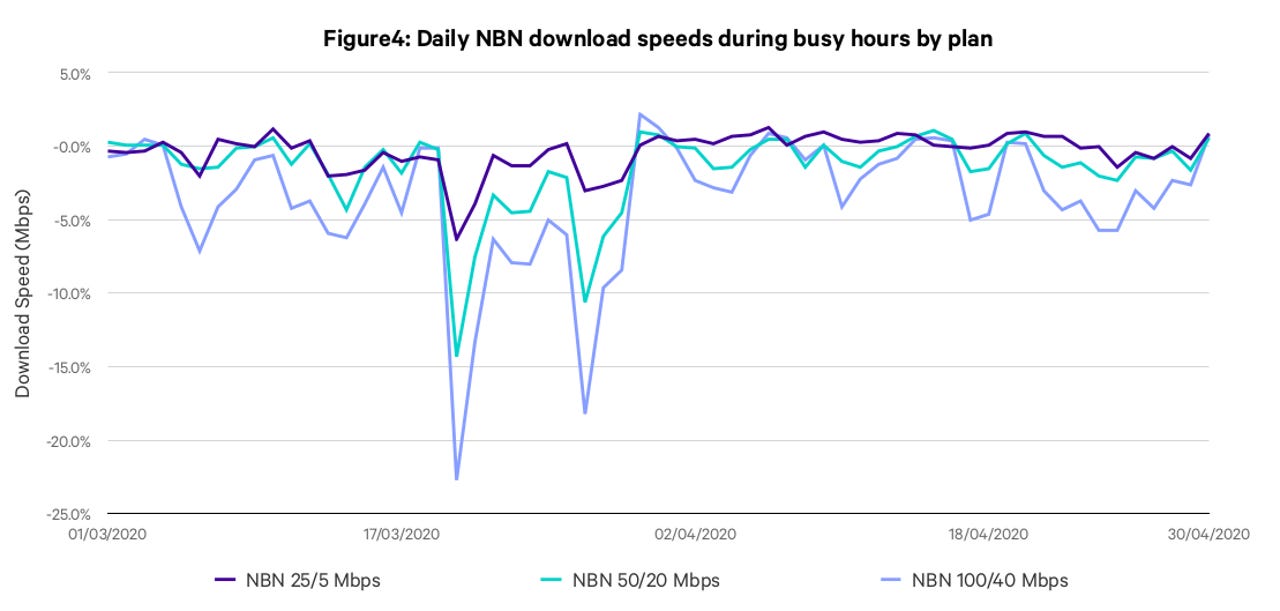It wasn't just you, the NBN was slower at the back end of March


The Australian Competition and Consumer Commission (ACCC) released its first monthly edition of its Measuring Broadband Australia report on Thursday, which covered the performance of the National Broadband Network (NBN) between February and April.
The report showed that from the start of coronavirus lockdowns in mid-March, during busy hours, users on 50Mbps and 100Mbps plans experienced drops of up to 14% and 23%, respectively. Users on 25Mbps plan were only hit with a 5% degradation in busy hours. No 12Mbps services were included due to a lack of sufficient sample size.
Measuring across all hours, the drops in speeds translated into 12% for 100Mbps, 8% for 50Mbps, and only a few percent for 25Mbps.
Across April, 100Mbps users saw degradation of up to 5% in busy hours, with the other two plans only impacted by a couple of percent.
The ACCC pinned the April improvement on the 40% capacity boost that NBN offered retailers. NBN extended its offer until the end of July, and has also noted it experiences peak traffic when there are major game updates, such as a Call of Duty update on April 8 that resulted in a 13.8Tbps peak.
A similar degradation at higher speeds was also shown on the broadband networks of New Zealand, with Commerce Commission releasing its latest instalment of the Measuring Broadband New Zealand report on Thursday. Although in the case of New Zealand, the 100Mbps plan performed well.
The report said on average, fixed line connections across New Zealand were unaffected by lockdowns, with the exception of Fibre Max speeds dropping by 8% in the afternoon, and 4% at other times, while fixed wireless saw drops of 32% in the afternoon and up to 25% at other times.
The Commerce Commission also highlighted latency differences between the North and South Islands of the country, with North Island ISPs able to fetch an image from Facebook with between 4.2ms and 6.6ms of latency, while South Island ISPs sat at 11.3ms.
"In practical terms, this difference in latency would have no effect on user experience, but it does illustrate that latency to real applications is not always the same across both islands," it said.
In terms of latency, the report added there was no difference between Fibre 100 and Fibre Max plans.
"Fibre Max does not outperform Fibre 100 in terms of latency and so is not necessarily better for heavy gaming," it said.
Back across the Tasman, the quarterly version of the broadband report showed Telstra had the lowest latency of the measured retailers during February.
Hot on its heels was Exetel and Optus, followed by Dodo, TPG, Aussie Broadband, Vodafone, iiNet, and MyRepublic.
MyRepublic remained at the rear of the field in a webpage loading time test, which was taken out by Telstra and Exetel on 2.5 seconds. This was followed by Aussie Broadband with 2.6 seconds, Optus and iiNet with 2.8 seconds, TPG and Dodo at 2.9 seconds, Vodafone at 3 seconds, and MyRepublic at 3.4 seconds.
In terms of pure speed, Optus maintained its mantle as having the highest download speeds, but second and third-placed Exetel and TPG were able to outdo it on upload speeds.
Dodo and iPrimus also improved by two percentage points on the amount of bandwidth percentage delivered during busy periods compared to the maximum speed of the service being used, but still trailed the field on both upload and download speeds.
Even before coronavirus took hold, 100Mbps plans were seeing more degradation in February compared to slower speeds.
"The 100/40Mbps NBN tier remains most affected by increased user activity in the evening hours: Speeds typically started to decrease after 5pm, dipping to 5.2Mbps below the day's maximum by 8pm, and would recover to higher levels after 11pm," the ACCC said.
Of the 1,270 connections tested for the February report, 10% were classed as underperforming, a category where less than 75% of advertised speeds are reached, and 95% of underperforming services were using fibre to the node (FttN) technology.
"Within the 50/20Mbps tier, fibre to the node services had an average download speed around 5Mbps lower than other technologies. Within the 100/40Mbps tier, fibre to the node services had an average download speed around 12Mbps lower than other technologies," it said.
As a result, in busy periods, 100Mbps FttN connections can only hit 75Mbps on average, and even when underperforming lines are excluded, is able to hit 86.4Mbps overall, compared to 89.6Mbps for HFC, and 90.1Mbps for fibre to the premises.
Continuing a trend of complaining that its layer 7 tests cannot reach 100% of layer 2 allocated speeds, the ACCC pointed out its speeds test could only reach up to 95.6% of advertised speeds.
By the middle of the year, NBN will add an overhead allocation to downstream connections of up to 15%, with the exception of 1Gbps plans.
Potentially, this could allow a retailer to start advertising a 60Mbps plan on a 50Mbps service. Thanks, ACCC.
Related Coverage
NBN broadband tax clears Parliament
After a number of false starts, the Regional Broadband Scheme is set to become law.
NBN reports nine-month revenue up by over a third but EBITDA loss only closes by 9%
Payments to Telstra and Optus are now just shy of AU$2 billion over nine months.
Commonwealth claims NBN has capacity to handle IoT and smart transport initiatives
The federal government also touted there will be greater data collection and visibility across federal and state governments to improve livability outcomes for cities.
Australian telco networks to get AU$37 million disaster resiliency boost
Commonwealth to fund improvements to base station batteries, satellite links at fire depots, and portable temporary connectivity.
NBN lines up AU$6.1 billion in bank credit
Although it initially wanted AU$2 billion, Australia's broadband wholesaler walked away with a AU$6.1 billion line of credit.